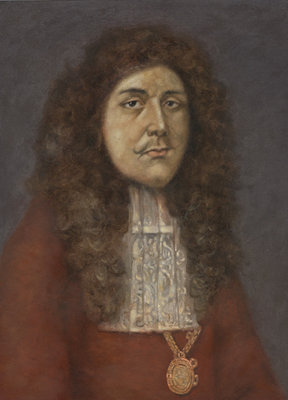| B i o g r a p h y |
 Heinrich Ignaz
Franz von Biber (12 August 1644 – 3 May 1704) was a
Bohemian-Austrian composer and violinist. Born in the small Bohemian
town of Wartenberg, Biber worked at Graz and Kroměříž before he
illegally left his Kroměříž employer and settled in Salzburg. He
remained there for the rest of his life, publishing much of his music
but apparently seldom, if ever, giving concert tours. Biber was one of
the most important composers for the violin in the history of the
instrument. His technique allowed him to easily reach the 6th and 7th
positions, employ multiple stops in intricate polyphonic passages, and
explore the various possibilities of scordatura tuning. He also wrote
one of the earliest known pieces for solo violin, the monumental
passacaglia of the Mystery Sonatas. During Biber's lifetime, his music
was known and imitated throughout Europe. In late 18th century he was
named the best violin composer of the 17th century by music historian
Charles Burney. In late 20th century Biber's music, especially the
Mystery Sonatas, enjoyed a renaissance. Today, it is widely performed
and recorded.
Heinrich Ignaz
Franz von Biber (12 August 1644 – 3 May 1704) was a
Bohemian-Austrian composer and violinist. Born in the small Bohemian
town of Wartenberg, Biber worked at Graz and Kroměříž before he
illegally left his Kroměříž employer and settled in Salzburg. He
remained there for the rest of his life, publishing much of his music
but apparently seldom, if ever, giving concert tours. Biber was one of
the most important composers for the violin in the history of the
instrument. His technique allowed him to easily reach the 6th and 7th
positions, employ multiple stops in intricate polyphonic passages, and
explore the various possibilities of scordatura tuning. He also wrote
one of the earliest known pieces for solo violin, the monumental
passacaglia of the Mystery Sonatas. During Biber's lifetime, his music
was known and imitated throughout Europe. In late 18th century he was
named the best violin composer of the 17th century by music historian
Charles Burney. In late 20th century Biber's music, especially the
Mystery Sonatas, enjoyed a renaissance. Today, it is widely performed
and recorded.
Biber was born in Wartenberg, Bohemia (now Stráž pod Ralskem, Czech
Republic). Little is known about his early education, other than that
he may have studied at a Jesuit Gymnasium in Bohemia. Before 1668 Biber
worked at the court of Prince Johann Seyfried von Eggenberg in Graz,
and then was employed by the Bishop of Olmütz (now Olomouc), Karl II
von Liechtenstein-Kastelkorn, in Kroměříž. Biber's associate from the
early 1660s, Pavel Josef Vejvanovský, worked there as director of the
Kapelle. Biber apparently enjoyed a good reputation, and his violin
playing skills were very highly regarded.In summer 1670 Karl II sent
Biber to Absam, near Innsbruck, to negotiate with the celebrated
instrument maker Jacob Stainer for the purchase of new instruments for
the Kapelle. Biber never reached Stainer, however, and instead entered
the employ of the Archbishop of Salzburg, Maximilian Gandolph von
Kuenburg. Because Karl and Maximilian were friends, Biber's former
employer refrained from taking any action; he was, however, very hurt
by the composer's decision, and waited until 1676 to officially release
him. Biber remained in Salzburg for the rest of his life. His musical
and social careers flourished: he started publishing his music in 1676,
performed before the Emperor (and was rewarded by him) in 1677, became
deputy Kapellmeister at Salzburg in 1679 and Kapellmeister in 1684. In
1690 Biber was raised to nobility by the Emperor, with the title of
Biber von Bibern. Finally, the new Archbishop of Salzburg, Johann
Ernst, Count Thun, appointed Biber lord high steward, the highest
social rank Biber would attain. The composer got married on 30 May
1672. His wife Maria Weiss was a daughter of a Salzburg merchant.
Together they had 11 children, four of whom survived to adulthood. All
were musically gifted. Anton Heinrich (1679–1742) and Karl Heinrich
(1681–1749) both served as violinists at the Salzburg court, and the
latter was promoted to Kapellmeister in 1743. Daughters Maria Cäcilia
(born 1674) and Anna Magdalena (1677–1742) became nuns at Santa Clara,
Merano, and the Nonnberg Abbey, respectively. Anna Magdalena was an
alto singer and a violinist, and in 1727 became director of the choir
and the Kapelle of the Abbey.
Biber's violin music was inlfuenced, on one hand, by the Italian
tradition of Marco Uccellini and Carlo Farina, and on the other, by the
then-nascent German polyphonic tradition as exemplified by Johann
Heinrich Schmelzer, who may have been Biber's teacher. Biber's
achievements included further development of violin technique–he was
able to reach the 6th and 7th positions, and his left-hand and bowing
techniques were far more advanced than those of contemporary Italian
composers. He also excelled at counterpoint, frequently writing fully
polyphonic textures, with much use of multiple stops. Yet another area
in which Biber made a substantial contribution was the art of
scordatura, i.e. music for alternative tunings of the instrument.
Finally, much of Biber's music employs various forms of number
symbolism, affekten, programmatic devices, etc., as seen in, for
example, the symbolic retuning of the violin for the Resurrection
sonata of the Mystery Sonatas. During the latter half of the 17th
century Biber was, together with the composers of the Dresden school
(Johann Jakob Walther and Johann Paul von Westhoff), regarded as one of
the best and most influential violinists in Europe. However, soon after
his death, German violinists started following the style of Arcangelo
Corelli and his imitators.